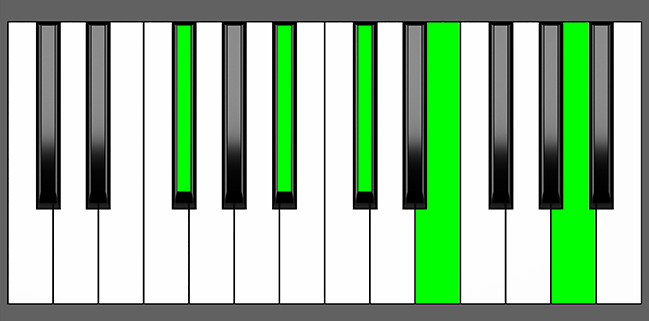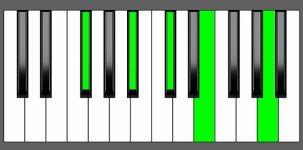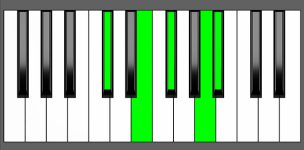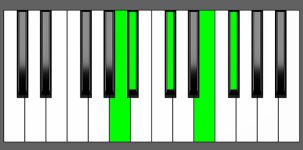Piano Diagram of Gb7#9 in Root Position

A Gb7#9 chord is an altered dominant seventh chord that is built upon the key of Gb. This chord consists of the root Gb, the major third Bb, the perfect fifth Db, the minor seventh Fb, and the sharp ninth A. The Gb7#9 chord can be used as a substitute for dominant chords only in specific musical contexts. Keep reading to learn more about the music theory that underpins this chord.
Structure of Gb7#9
Notes |
|---|
| Gb, Bb, Db, Fb, A |
Intervals |
|---|
| R, 3, 5, m7, #9 |
How to play a Gb7#9
To play a Gb7#9 chord, you can use the following voicing: start by playing the root note Gb with your left hand. Then, with your right hand, play the notes Bb (major 3rd), Fb (minor 7th), and A (sharp 9th).
Gb + Bb, Fb, A
This approach will result in a simplified Gb7#9 chord that includes only the essential notes: the root note, major 3rd, minor 7th, and sharp 9th.
Gb7#9 Chord Inversions
The Gb7#9 chord has a total of 4 inversions:
| Root Position: | Gb | Bb | Db | Fb | A |
| 1st Inversion: | Bb | Db | Fb | Gb | A |
| 2nd Inversion: | Db | Fb | Gb | A | Bb |
| 3rd Inversion: | Fb | Gb | A | Bb | Db |
| 4th Inversion: | A | Bb | Db | Fb | Gb |
Piano Keyboard Diagrams

Gb7#9 Chord – Root Position
- Gb7#9 Chord – 1st Inversion
- Gb7#9 Chord – 2nd Inversion
- Gb7#9 Chord – 3rd Inversion
- Gb7#9 Chord – 4th Inversion
Chord Inversions on Piano
Having a solid understanding of chord inversions is a crucial element of music theory since it sheds light on how chords are constructed. When it comes to playing chord inversions on a piano, it’s essential to keep in mind that the charts and graphs depicting the order of notes may not always be feasible or even playable.
To achieve the proper chord voicings on a piano, you must spread the chord notes across various octaves and positions on the keyboard. This often entails deviating from the typical shape of the chord’s inversions shown in charts, which may not be the most practical or comfortable way to play the chord.
While chord inversion charts can help understand the structure and sequence of notes in a chord, it’s always a good idea to experiment with different voicings and fingerings to find the most efficient and comfortable way to play the chord, while still preserving its intended harmonic function and sound.
Music Theory and Harmony of Gb7#9
Dominant 7#9 chords are often referred as the “Hendrix chord” due to their prominent use in songs like “Voodoo Child“, “Foxy Lady“, and “Purple Haze“. If you know these songs, then you can easily recall the distinct sound and mood of the 7#9 chord.
The Gb7#9 chord can replace or enhance the Gb7 chord, typically on the V degree, but also on the III degree, and occasionally on other degrees as a secondary dominant chord. However, it has a distinct funky vibe, so it should be used carefully in the appropriate musical context.
Before delving into the most frequent usage of this chord, let’s first understand how to construct it.
Building the Gb7#9 Chord: Different Approaches
Starting from the Gb Major Scale:
To form a 7#9 chord, you combine the root, the major 3rd, the 5th, the minor 7th, and the sharp 9th from a major scale.

Gb Major Scale

Gb Major Scale
To create a Gb7#9 chord, apply the formula R, 3, 5, m7, #9 in the following manner:
- Begin with the Root note, which is Gb.
- Select the major 3rd interval, which is Bb, and add it to the chord.
- Add the 5th interval, which is Db.
- Add the minor 7th interval, Fb.
- Finally, select the 9th, Ab, and add a half tone to get the #9th, A.
By following this simple formula, you can create a 7#9 chord from any major scale.
by Combining Intervals:
One method to create a 7#9 chord is by combining specific intervals – a major 3rd, a minor 3rd, and a perfect 4th.
3 + m3 + m3 + 4 = 7#9 Chords
For example, to build a Gb7#9 chord:
- we start with the root note Gb.
- We then add a major 3rd interval, which is four half-steps up from the root, to get Bb.
- Next, we add a minor 3rd interval, which is three half-steps up from Bb, to get Db.
- Then, we add another minor 3rd so we find the minor 7th Fb and
- lastly, we add a perfect 4th interval, which is five half-steps up from Fb, to get A.
Together, these intervals form the Gb7#9 chord.
How to Use Gb7#9 in a Chord Progression
The Gb7#9 can work as a substitute or as a passing chord to a Gb7 that can be found in major and natural minor scales. The 7#9 chord is considered a non-diatonic chord, which means that it contains notes that are not found in either the major or minor scales. Its unique sound is achieved by adding a sharp 9th interval (which is equivalent to a minor 3rd at the higher octave) to the dominant 7th chord, creating a dissonant yet interesting tonal color.
Most common uses of Gb7#9
Gb7#9 in B Major and B minor
The Gb7#9 chord is commonly used as a dominant chord. In the key of Cb major, the Gb7#9 chord can be used as the V7 chord, which leads back to the I chord (Cb major).
However, since Cb major is a theoretical key, we will refer to its enharmonic equivalent key, B major.
| Major Scale | I | ii | iii | IV | V | vi | vii |
|---|---|---|---|---|---|---|---|
| Cb = B | B Maj7 | C# min7 | D# min7 | E Maj7 | F#7 ⇒ F#7#9 = Gb7#9 | G# min7 | A#m7b5 |
- Substitute or Passing Chord to the Dominant chord in B Major as F#7#9
Gb7#9 as Substitute for Gb min7
The 7th chord derived from the harmonic minor scale is commonly used to replace a minor 7th chord. In this case, we are again in a theoretical key (Cb minor) so we will refer to its enharmonic equivalent key B minor.
| Minor Scale | i | ii | III | iv | v | VI | VII |
|---|---|---|---|---|---|---|---|
| Cb = B | B min7 | C#m7b5 | D Maj7 | E min7 | F# min7 ⇒ F#7 ⇒ F#7#9 = Gb7#9 | G Maj7 | A7 |
- Substitute or Passing Chord to the Dominant chord in B minor as F#7#9
Gb7#9 in a I – III7 Progression
The Gb7#9 chord could be used as a substitution for the III degree in an I – III7 chord progression, which features a Gb minor chord. Again, we will refer to its enharmonic equivalent chord F#7#9 since Ebb major is a theoretical key.
| Major Scale | I | ii | iii | IV | V | vi | vii |
|---|---|---|---|---|---|---|---|
| Ebb = D | D Maj7 | E min7 | F# min7 ⇒ F#7 ⇒ F#7#9 = Gb7#9 | G Maj7 | A7 | B min7 | C#m7b5 |
- Substitute or Passing Chord to the Mediant chord in D Major
Gb7#9 in Ab minor
While the Gb7#9 chord can be used in the key of Ab minor, it may not be the most common use of this chord.
| Minor Scale | i | ii | III | iv | v | VI | VII |
|---|---|---|---|---|---|---|---|
| Ab | Ab min7 | Bbm7b5 | Cb Maj7 | Db min7 | Eb min7 | Fb Maj7 | Gb7 ⇒ Gb7#9 |
- Substitute or Passing Chord to the Leading Tone chord in Ab minor (less common)
Gb7#9 as Substitute for a Secondary Dominant 7th chord
Ab secondary dominant is a type of chord that is not in the main key of a musical piece but is used to create a strong pull towards another chord that is. In Western music, the fifth scale degree has a strong “dominant” function and creates tension that resolves to the first scale degree chord (I). Ab secondary dominant chord is used to create this same dominant function but towards a different chord, leading to a temporary departure from the main key.
For example, in the theoretical key of Fb major, the chord of Cb7 is the V chord and leads back to the I chord of Fb Maj7. Adding another chord between Fb Maj7 and Cb7 that creates a strong pull towards Cb7 creates a secondary dominant chord. In this case, using a Gb7 chord creates a pull towards Cb7, as Gb7 is the V chord in the key of Cb.
| Fb Maj7 | Cb7 |
⇒
| Fb Maj7 | Gb7 | Cb7 |
Instead of using a regular Gb7 chord, you can also use the Gb7#9 chord in place of or together with it. This substitution or addition can add more tension and complexity to the progression, leading to a more interesting and dynamic result.
| Fb Maj7 | Cb7 |
⇒
| Fb Maj7 | Gb7/Gb7#9 | Cb7 |
Gb7#9 Chord Function in Major and Minor Keys
Gb7#9 as Dominant Chord in Cb Major
Gb7#9 as Dominant Chord in Cb minor
Gb7#9 as III7 Degree in Ebb Major
Gb7#9 as Leading Tone Chord in Ab minor
In the key of Ab minor, the Gb7 chord is built on the leading tone, which is the seventh note of the scale. This chord can be replaced or modulated by a Gb7#9, although it may not be the most ideal position for this chord. Nonetheless, it can still be a valid option in certain musical contexts.
| i | ii | III | iv | v | VI | VII |
| Ab min7 | Bbm7b5 | Cb Maj7 | Db min7 | Eb min7 | Fb Maj7 | Gb7 |
Gb7#9 as VII degree – Chord Progressions
i iv VII i
| i | iv | VII | i |
| Ab min7 | Db min7 | Gb7#9 | Gb7b9 | Ab min7 |
i iv VII III
| i | iv | VII | III |
| Ab min7 | Db min7 | Gb7#9 | Gb7b9 | Cb Maj7 |
Circle Progression
| i | iv | VII | III | VI | ii | V7 | i |
| Ab min7 | Db min7 | Gb7#9 | Gb7b9 | Cb Maj7 | Fb Maj7 | Bbm7b5 | Eb7 | Ab min7 |
Alternative Gb7#9 Nomenclature
- Gb 7+9
- Gb 7(#9)
- Solb 7#9
- Gb 7#9th
- Gb dom7#9
- Gb Dominant 7th #9
- Gb Dominant Seventh Sharp Ninth



